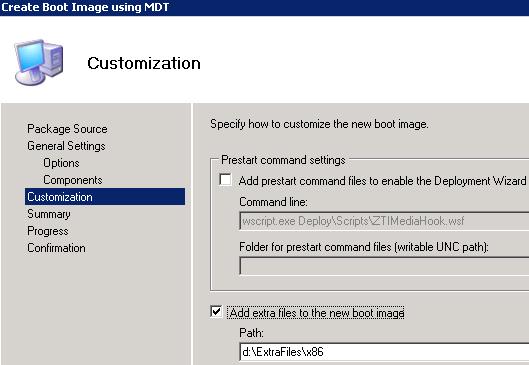' February 2013
' by Romano Jerez
'
' OK to use and distribute if author information is kept
' ===========================================================
Option Explicit
Dim strPCList, objFSO, objWshNet, strLocalPC, objPCFile, strCurrentLine
Dim arrayName, strOldName, strNewName, intExitCode, objComputer
Dim objWMIService, Return, bFound, strLocalLogFile, objLocalLogFile
Dim strUserAccount, strUserPassword, strRemoteLogFileSuccess
Dim strRemoteLogFileFail, strRemoteLogFileNoRename, objRemoteLogFileSuccess
Dim objRemoteLogFileFail, objRemoteLogFileNoRename, bSameName
Dim strRemoteLogFileSuccessShare, strRemoteLogFileFailShare
Dim strRemoteLogFileNoRenameShare
Const ForReading = 1
Const ForWriting = 2
Const ForAppending = 8
' *** Configure file with computer list ***
strPCList = "\\<serverName>\<shareName>\renameList.txt"
' *****************************************
' *** Configure local log File and remote log locations ***
'
strLocalLogFile = "c:\windows\temp\pcRename.log"
strRemoteLogFileSuccessShare = "\\<serverName>\<shareName>\Success"
strRemoteLogFileFailShare = "\\<serverName>\<shareName>\Fail"
strRemoteLogFileNoRenameShare = "\\<serverName>\<shareName>\NoRenameAttempt"
'
' ********************************
' *** Configure Account with permissions to rename computer in AD ***
'
strUserAccount = "<domainName>\<domainAccount>"
strUserPassword = "<password>"
'
' ********************************
Set objWshNet = CreateObject("WScript.Network")
Set objFSO = CreateObject("Scripting.FileSystemObject")
strLocalPC = objWshNet.ComputerName
strRemoteLogFileSuccess = strRemoteLogFileSuccessShare & "\" & strLocalPC & ".txt"
strRemoteLogFileFail = strRemoteLogFileFailShare & "\" & strLocalPC & ".txt"
strRemoteLogFileNoRename = strRemoteLogFileNoRenameShare & "\" & strLocalPC & ".txt"
initializeLogging
Set objPCFile = objFSO.OpenTextFile(strPCList, ForReading)
intExitCode = 99
bSameName = vbFalse
bFound = vbFalse
Do Until (objPCFile.AtEndOfStream)
strCurrentLine = objPCFile.Readline
If Len(strCurrentLine) > 0 Then
arrayName = Split(strCurrentLine, ",", -1, 1)
strOldName = Trim(arrayName(0))
strNewName = Trim(arrayName(1))
If strLocalPC = strOldName Then
bFound = vbTrue
If (Len(strNewName)) > 15 Then
WScript.Echo "Not renaming as new name has more than 15 characters: " & strNewName
writeToLog("Not renaming as new name has more than 15 characters: " & strNewName)
LogNoRename("Not renaming as new name has more than 15 characters: " & strNewName)
ElseIf strOldName = strNewName Then
bSameName = vbTrue
WScript.Echo "Not renaming as old and New name are the same for " & strLocalPC
writeToLog("Not renaming as old and New name are the same for " & strLocalPC)
LogNoRename("Not renaming as old and New name are the same for " & strLocalPC)
Else
WScript.Echo "Old name: " & strOldName & ". Changing to " & strNewName
writeToLog("Old name: " & strOldName & ". Changing to " & strNewName)
intExitCode = Rename(strNewName)
End If
End If
End If
Loop
If Not bFound Then
WScript.Echo strLocalPC & " not found in list as old computer. No renaming attempted."
writeToLog(strLocalPC & " not found in list as old computer. No renaming attempted.")
LogNoRename(strLocalPC & " not found in list as old computer. No renaming attempted.")
End If
If intExitCode = 99 Then ' didn't run Rename function
intExitCode = 0 ' but return that the script ran successfully
End If
cleanUp
WScript.Quit(intExitCode)
' *********************************************************************
Sub cleanUp
WScript.Echo "Exit code: " & intExitCode
writeToLoG("Exit code: " & intExitCode)
objPCFile.Close
objLocalLogFile.Close
End Sub
' *****************
Sub initializeLogging
If objFSO.FileExists(strLocalLogFile) Then
Set objLocalLogFile = objFSO.OpenTextFile(strLocalLogFile, ForAppending)
Else
Set objLocalLogFile = objFSO.CreateTextFile(strLocalLogFile)
objLocalLogFile.Close
Set objLocalLogFile = objFSO.OpenTextFile(strLocalLogFile, ForWriting)
End If
objLocalLogFile.WriteLine(Now())
End Sub
' *****************
Sub LogNoRename(strMessage)
If objFSO.FileExists(strRemoteLogFileNoRename) Then
Set objRemoteLogFileNoRename = objFSO.OpenTextFile(strRemoteLogFileNoRename, ForAppending)
Else
Set objRemoteLogFileNoRename = objFSO.CreateTextFile(strRemoteLogFileNoRename)
objRemoteLogFileNoRename.Close
Set objRemoteLogFileNoRename = objFSO.OpenTextFile(strRemoteLogFileNoRename, ForWriting)
End If
objRemoteLogFileNoRename.WriteLine(Now())
objRemoteLogFileNoRename.WriteLine(strMessage)
objRemoteLogFileNoRename.Close
End Sub
' ******************
Sub LogRenameFailed(strMessage)
If objFSO.FileExists(strRemoteLogFileFail) Then
WScript.Echo "File exists"
Set objRemoteLogFileFail = objFSO.OpenTextFile(strRemoteLogFileFail, ForAppending)
Else
Set objRemoteLogFileFail = objFSO.CreateTextFile(strRemoteLogFileFail)
objRemoteLogFileFail.Close
Set objRemoteLogFileFail = objFSO.OpenTextFile(strRemoteLogFileFail, ForWriting)
End If
objRemoteLogFileFail.WriteLine(Now())
objRemoteLogFileFail.WriteLine(strMessage)
objRemoteLogFileFail.Close
End Sub
' ******************
Sub LogRenameSucceded(strMessage)
If objFSO.FileExists(strRemoteLogFileSuccess) Then
Set objRemoteLogFileSuccess = objFSO.OpenTextFile(strRemoteLogFileSuccess, ForAppending)
Else
Set objRemoteLogFileSuccess = objFSO.CreateTextFile(strRemoteLogFileSuccess)
objRemoteLogFileSuccess.Close
Set objRemoteLogFileSuccess = objFSO.OpenTextFile(strRemoteLogFileSuccess, ForWriting)
End If
objRemoteLogFileSuccess.WriteLine(Now())
objRemoteLogFileSuccess.WriteLine(strMessage)
objRemoteLogFileSuccess.Close
End Sub
' ****************************************
Function Rename(strName)
Set objWMIService = GetObject("Winmgmts:root\cimv2")
For Each objComputer in objWMIService.InstancesOf("Win32_ComputerSystem")
Return = objComputer.Rename(strName,strUserPassword,strUserAccount)
If Return <> 0 Then
WScript.Echo "Rename to " & strName & " failed. Error = " & Err.Number
writeToLog("Rename to " & strName & " failed. Error = " & Err.Number)
LogRenameFailed("Rename to " & strName & " failed. Error = " & Err.Number & vbCrLf & "Exit code: " & Return)
Else
WScript.Echo "Rename to " & strName & " succeeded. Restart is needed."
writeToLog("Rename to " & strName & " succeeded. Restart is needed.")
LogRenameSucceded("Rename to " & strName & " succeeded. Restart is needed.")
End If
Next
Rename = Return
End Function
' ***************************************
Sub writeToLog(strMessage)
objLocalLogFile.WriteLine(strMessage)
End Sub
' ***************************************














